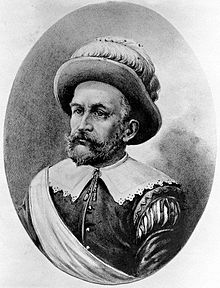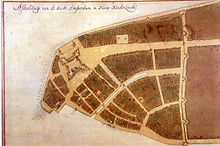See also: History of New York City
| History of New York City |
|---|
| Lenape and New Netherland, to 1664 New Amsterdam British and Revolution, 1665–1783 Federal and early American, 1784–1854 Tammany and Consolidation, 1855–1897 (Civil War, 1861–1865) Early 20th century, 1898–1945 Post–World War II, 1946–1977 Modern and post-9/11, 1978– |
| See also |
| Timelines: NYC • Bronx • Brooklyn • Queens • Staten Island Category |
Colonial era
Peter Minuit, early 1600s.
The Castello Plan showing the Dutch colonial city of New Amsterdam in 1660 – then confined to the southern tip of Manhattan Island.
It was not until the voyage of Henry Hudson, an Englishman who worked for the Dutch East India Company, that the area was mapped.[40] Hudson came across Manhattan Island and the native people living there in 1609, and continued up the river that would later bear his name, the Hudson River, until he arrived at the site of present-day Albany.[41]
J.Q.A. Ward's statue of George Washington in front of Federal Hall (on Wall Street) where he was inaugurated as the first U.S. President in 1789.[42]
According to a letter by Pieter Janszoon Schagen, Peter Minuit and Dutch colonists acquired Manhattan on May 24, 1626, from unnamed Native American people, which are believed to have been Canarsee Indians of the Lenape,[46] in exchange for trade goods worth 60 guilders,[15] often said to be worth US$24, although accounting for inflation, it actually amounts to around US$1,050 in 2014.[47] The figure of 60 guilders comes from a letter by a representative of the Dutch States-General and member of the board of the Dutch West India Company, Pieter Janszoon Schagen, to the States-General in November 1626.[48] In 1846, New York historian John Romeyn Brodhead converted the figure of Fl 60 (or 60 guilders) to US$23.[49] "[A] variable-rate myth being a contradiction in terms, the purchase price remains forever frozen at twenty-four dollars," as Edwin G. Burrows and Mike Wallace remarked in their history of New York.[50] Sixty guilders in 1626 was valued at approximately $1,000 in 2006, according to the Institute for Social History of Amsterdam.[51] Based on the price of silver, Straight Dope author Cecil Adams calculated an equivalent of $72 in 1992.[52] Historians James and Michelle Nevius revisited the issue in 2014, suggesting that using the prices of beer and brandy as equivalencies, the price Minuit paid would have the purchasing power of somewhere between $2,600 and $15,600 in current dollars.[53] According to the writer Nathaniel Benchley, Minuit conducted the transaction with Seyseys, chief of the Canarsees, who were willing to accept valuable merchandise in exchange for the island that was actually mostly controlled by the Weckquaesgeeks.[54]
In 1647, Peter Stuyvesant was appointed as the last Dutch Director General of the colony.[55] New Amsterdam was formally incorporated as a city on February 2, 1653.[56] In 1664, the English conquered New Netherland and renamed it "New York" after the English Duke of York and Albany, the future King James II.[57] The Dutch, under Director General Stuyvesant, successfully negotiated with the English to produce 24 articles of provisional transfer, which sought to retain for the extant citizens of New Netherland their previously attained liberties (including freedom of religion) under new colonial English rulers.[58][44]
The Dutch Republic regained it in August 1673 with a fleet of 21 ships, renaming the city "New Orange". New Netherland was ceded permanently to the English in November 1674 through the Treaty of Westminster,[59] in exchange for Run Island which was the long-coveted last link in the Dutch nutmeg trading monopoly in Indonesia.[60]
American Revolution and the early United States
Manhattan was at the heart of the New York Campaign, a series of major battles in the early American Revolutionary War. The Continental Army was forced to abandon Manhattan after the Battle of Fort Washington on November 16, 1776. The city, greatly damaged by the Great Fire of New York during the campaign, became the British political and military center of operations in North America for the remainder of the war.[61] British occupation lasted until November 25, 1783, when George Washington returned to Manhattan, as the last British forces left the city.[62]From January 11, 1785, to the fall of 1788, New York City was the fifth of five capitals of the United States under the Articles of Confederation, with the Continental Congress meeting at New York City Hall (then at Fraunces Tavern). New York was the first capital under the newly enacted Constitution of the United States, from March 4, 1789, to August 12, 1790, at Federal Hall.[63] Federal Hall was also the site of where the United States Supreme Court met for the first time,[64] the United States Bill of Rights were drafted and ratified,[65] and where the Northwest Ordinance was adopted, establishing measures for adding new states to the Union.[66]



No comments:
Post a Comment